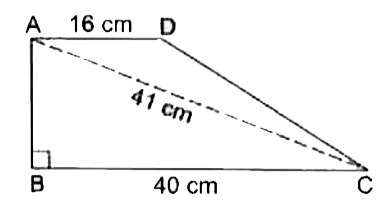ABCD is a trapezium in which AD II BC . AB = 9 cm, BC =12 cm, CD = 15 cm, DA = 20 cm. Find the sum of square of diagonals.
686
720
786
700
Step by step video & image solution for ABCD is a trapezium in which AD II BC . AB = 9 cm, BC =12 cm, CD = 15 cm, DA = 20 cm. Find the sum of square of diagonals. by Maths experts to help you in doubts & scoring excellent marks in Class 14 exams.
Updated on:21/07/2023Topper's Solved these Questions
Similar Questions
Knowledge Check
ABCD is a trapezium in which AB∣∣CD,AB=20cm,BC=10 cm, CD=10 cm and AD=10 cm . Find ∠ADC
A80∘B100∘C120∘D140∘ABCD is a trapezium in which AB∣∣CD,AB=20cm,BC=10 cm, CD=10 cm and AD=10 cm . Find ∠ADC
A80∘B100∘C120∘D140∘Find the area of a trapezium ABCD in which AB || DC, AB = 26cm, BC = 25cm, CD = 40cm and DA = 25cm.
A648cm2B792cm2C660cm2D798cm2
ABCD is a trapezium in which AB || DC, ABデ78 cm, CD = 52 cm. AD = 28 cm and BC =30cm . Find the area of the trapezium.
View SolutionIn the given figure, ABCD is a trapezium in which AD∣∣BC,∠ABC=90∘,AD=16cm,AC=41cm and BC = 40 cm. Find the area of the trapezium.

View SolutionABCD is a cyclic trapezium & ABII CD, AB is diameter. BC = 2cm, AB = 8 cm, CD = ?
View SolutionABCD is a cyclic trapezium & AB is diameter. BC = 2cm, AB = 8 cm, CD = ?
View SolutionABCD is a trapezium, where AB is parallel to DC. If AB = 4cm, BC = 3 cm, CD = 7 cm and DA = 2cm, then what is the area of the trapezium?
View Solution
